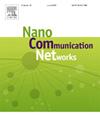TRMAC: A time-reversal-based MAC protocol for wireless networks within computing packages
IF 4.7
4区 计算机科学
Q2 ENGINEERING, ELECTRICAL & ELECTRONIC
引用次数: 0
Abstract
As chiplet-based integration and many-core architectures become the norm in computing, on-chip wireless communication has emerged as a compelling alternative to traditional interconnects. However, scalable Medium Access Control (MAC) remains a fundamental challenge, particularly under dense traffic and limited spectral resources. This paper presents TRMAC, a novel cross-layer MAC protocol that exploits the spatial focusing capability of Time Reversal (TR) to enable multiple parallel transmissions over a shared frequency channel. By leveraging the quasi-deterministic nature of on-chip wireless channels, TRMAC pre-characterizes Channel Impulse Responses (CIRs) to coordinate access using energy-based thresholds, eliminating the need for orthogonal resource allocation or centralized arbitration. Through detailed physical-layer simulation and system-level evaluation on diverse traffic, TRMAC demonstrates comparable or superior performance to existing multi-channel MAC protocols, achieving low latency, high throughput, and strong scalability across hundreds of cores. Moreover, we prove that TRMAC can be utilized for parallel transmissions with a single frequency channel with a similar throughput and latency as in using multiple frequency bands, omitting the need for complex transceivers.
TRMAC:一种基于时间反转的MAC协议,用于计算包内的无线网络
随着基于芯片的集成和多核架构成为计算领域的标准,片上无线通信已经成为传统互连的一个引人注目的替代方案。然而,可扩展的介质访问控制(MAC)仍然是一个根本性的挑战,特别是在密集的流量和有限的频谱资源下。TRMAC是一种新颖的跨层MAC协议,它利用时间反转(TR)的空间聚焦能力,在共享频率信道上实现多个并行传输。通过利用片上无线信道的准确定性特性,TRMAC预先表征了信道脉冲响应(CIRs),使用基于能量的阈值来协调访问,从而消除了正交资源分配或集中仲裁的需要。通过详细的物理层仿真和对不同流量的系统级评估,TRMAC表现出与现有多通道MAC协议相当或更好的性能,实现了低延迟、高吞吐量和跨数百核的强大可扩展性。此外,我们证明TRMAC可以用于单频通道的并行传输,其吞吐量和延迟与使用多个频段相似,从而无需复杂的收发器。
本文章由计算机程序翻译,如有差异,请以英文原文为准。
求助全文
约1分钟内获得全文
求助全文
来源期刊

Nano Communication Networks
Mathematics-Applied Mathematics
CiteScore
6.00
自引率
6.90%
发文量
14
期刊介绍:
The Nano Communication Networks Journal is an international, archival and multi-disciplinary journal providing a publication vehicle for complete coverage of all topics of interest to those involved in all aspects of nanoscale communication and networking. Theoretical research contributions presenting new techniques, concepts or analyses; applied contributions reporting on experiences and experiments; and tutorial and survey manuscripts are published.
Nano Communication Networks is a part of the COMNET (Computer Networks) family of journals within Elsevier. The family of journals covers all aspects of networking except nanonetworking, which is the scope of this journal.
 求助内容:
求助内容: 应助结果提醒方式:
应助结果提醒方式:


